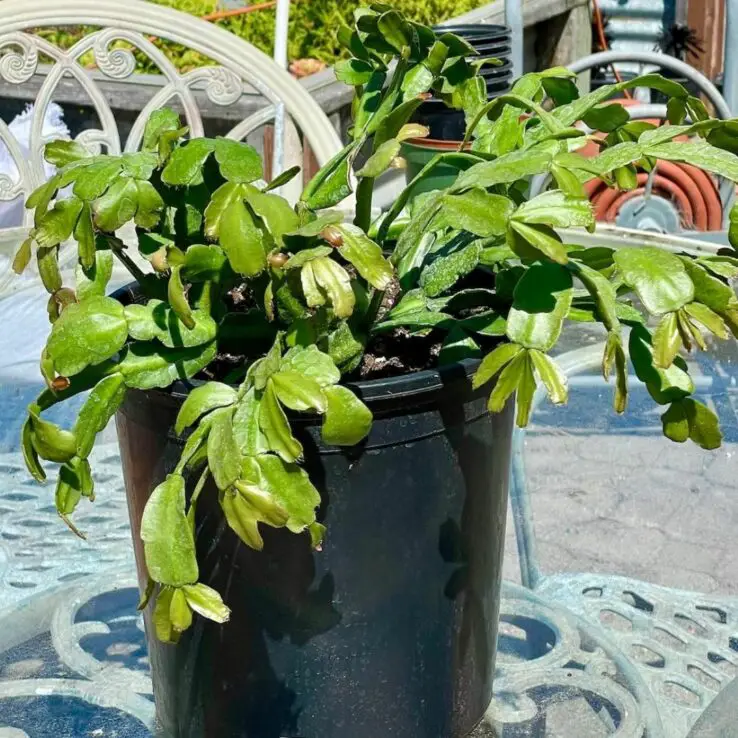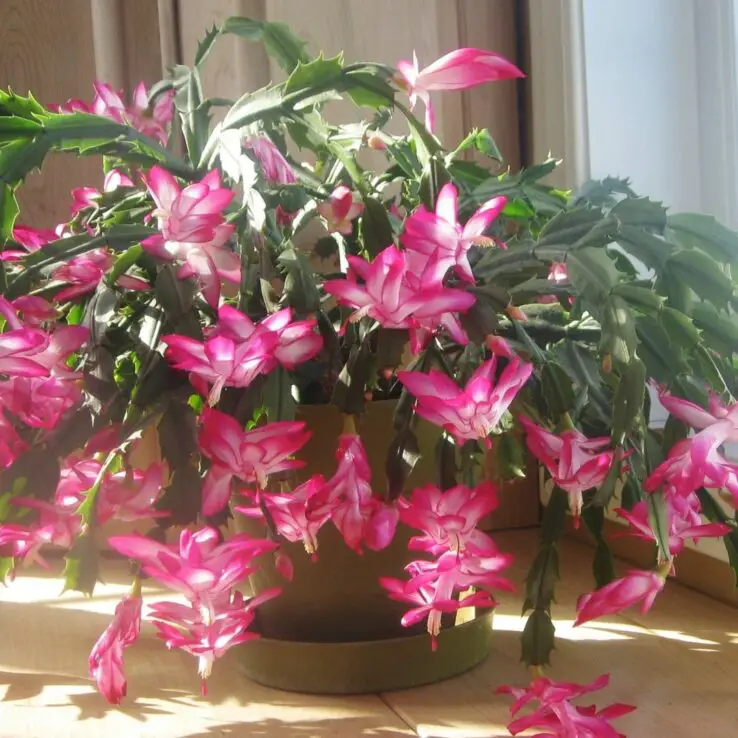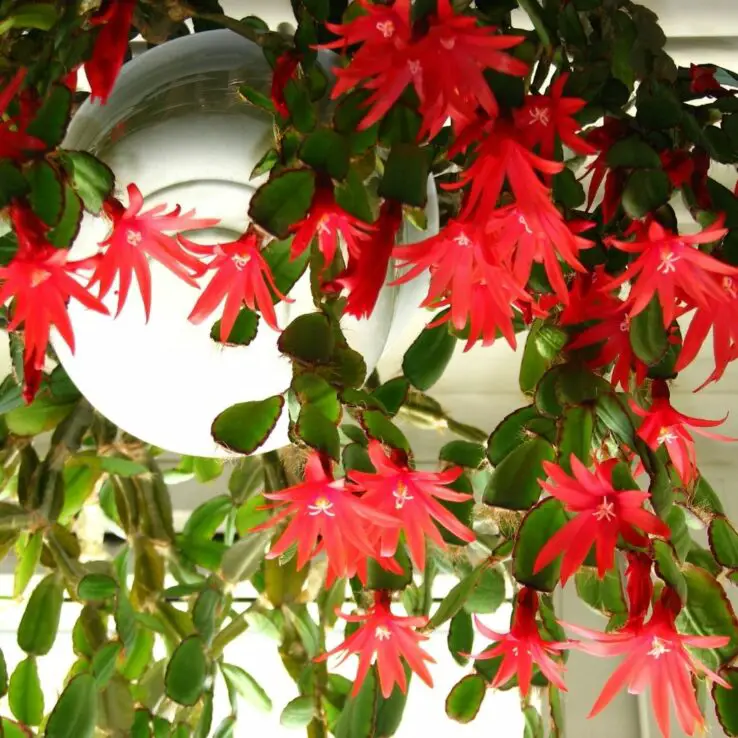
Growing Christmas Cactus
Christmas Cactus, Thanksgiving, and Easter Cacti are all holiday favorites that can be grown as houseplants with some effort and dedication. One of the reasons why these plants are popular is because they bloom in winter or springtime when others have gone dormant.
The Christmas cactus plant produces pink-petaled blooms with rounded edges while the Thanksgiving cacti produce dark red blossoms and the Easter cacti produce white blossoms to celebrate their respective holidays.
Growing a Christmas cactus is an easy task for anyone who has access to a windowsill or bright spot outdoors or indoors where it will get enough shaded light daily during fall months.
About Christmas Cactus
The Christmas cactus (Schlumbergera x buckleyi) and its relatives do not flourish in hot air, dry places like deserts, or plains. In reality, the Christmas cactus is native to southern Brazil, where it grows as an epiphyte in rainforests. It uses its roots to attach to trees but absorbs the majority of moisture and nutrients from the air of the humid forests, and benefit from shaded light and a warm environment.
Unlike other desert relatives cacti, the Christmas cactus (Schlumbergera x buckleyi) is tolerant of lower light conditions, which makes it a popular houseplant.
This cactus lives and blooms in the winter season when other plants are usually dormant. Since they are tropical plants, they need more humidity in the air to thrive.
In short words: Don't treat a Christmas cactus the same as other plants. They can't withstand the same amount of bright light, dry weather that other succulent plants can. It's crucial to water these more frequently than most succulent plants, but avoid keeping them too wet.
Christmas cactus is classified as a forest cactus.
The different types of Christmas Cacti
There are mainly 3 types of “holiday” cacti: the Easter cactus (S. Gaertneri), the Thanksgiving cacti (S. Truncata), and the Christmas cactus (S. x Buckleyi). All three of these species are sometimes known as "Christmas cactus" because this is the most widely used name.
All three are in the same family, but their care and looks vary to some extent. So you should know which one to buy because all of them produce different color flowers.
As our care instructions apply to all of them! So we'll also refer to all of them as Christmas cactus.
Christmas Cactus (Schlumbergera x buckleyi):

This comes from woody, evergreen trees of tropical rainforests where it likes to grow on tree branches in the dim shade.
These produce flowers during winter or spring seasons that resemble hyacinths and are colored white, pink, or red. They prefer bright, but indirect sunlight and consistent watering.
Thanksgiving Cactus (Schlumbergera truncata):

This is also a tropical cactus that grows in the wild on trees and rocks. It's native to southeastern Brazil and produces blooms at Thanksgiving time (fall season).
These flowers are like hyacinths as well but come in various colors, such as orange-red, yellowish-brown, whitish-pink, and purple.
Easter Cactus (Schlumbergera gaertneri):

The flowers of this cactus open at dawn and close around noon or in the early afternoon. The flowers are star-shaped and in many colors, like white, pink, or dark scarlet with darker veins.
This beautiful plant bloom from spring to summer and prefer warm areas with bright indirect sunlight. Its cultivars are available in different colors.
Planting Christmas cactus
The best time to plant the beautiful holiday plant is during springtime or summer, but you can also plant them during mid-October.
Choose a pot with having a drainage hole, fill it with well-drained succulents fresh soil mix, and place it in an area where it will receive indirect sunlight, so they can thrive indoors without getting too much sunlight directly.
Water your Christmas cactus regularly, and add fertilizer once a month or so while the plant is in the actively growing season.
When to repot
Christmas cactus does not require frequent repotting, so wait until you have a good reason to repot. When the plant is "pot bound", it blooms better.
Repot only when the roots are crowded and the pot is sagging and your plant shows poor health. If your plant blooms during late fall or winter, reduce watering instead of transplanting.
Where to put Christmas cactus
Christmas cactus flourish at normal room temperature and usually do not need any special care. However, the following are the best places to keep your Holiday cactus indoors.
- Keep it in a bright, indirect light source. But avoid too much direct sunlight as it can damage your plant. It could be east-facing window, bed room, or even your bright bathroom.
- A minimum of 70°F (21°C) in the daytime and 60-65°F (15-18°C) at night is ideal.
- Christmas cactus may be kept in the outdoor garden until temperatures drop below 50°F (10°C) in the summer. But, avoid keeping them in direct sunlight.
- You can also provide them with artificial light during the day, if your room is darker.
- Like its natural habitat, it thrives in humid environments so, keep it in your bathroom or kitchen to see blooms.
How to grow and care for a Christmas cactus
Christmas Cactus need bright light but not too much sunlight directly. The best area is an east-facing window, bedroom, kitchen, or even bathroom that has indirect natural light during the day and artificial light at night if necessary. You can also provide them with artificial light during the day if needed; they thrive in humid environments, where they will be able to bloom happily all winter long!
Here are the points that you should follow for growing and caring for a Christmas cactus.
Proper Watering Schedule
Water only when the top 1/3 of soil feels dry. You can water it every week or 2, depending on your indoor environment humidity, air circulation, and temperature. When watering, soak the soil completely until the water runs out of the pot's drainage hole.
After about 15 minutes, discard any excess water in the bottom waterproof saucer (tray).
During blooming, water the plant a little more, but keep an eye on overwatering indications. You can water every week, but once you do, do it well for up to 10-20 minutes.
Do not overwater your plant, as it can cause several problems. If leaves are dropping, the soil is always wet or the stem is soft and mushy which means you are overwatering or your draining medium is poor. Keep in mind that Christmas cactus growth begins during the early spring to summer seasons so it needs more water than in winter.
Learn more about how to water Christmas tree cactus.
Proper Soil selection
For growing Christmas cactus, you will need a well-drained potting mix.
Ingredients for making succulents soil/cacti potting mix:
- 1 part potting soil (or any regular garden dirt)
- 2 parts coarse sand or perlite
Ensure that you use the right pot with a proper drainage system, water only when the soil is dry. Use a toothpick to check whether it has enough moisture or not. Soil shouldn't be wet.
You can also get a well-draining soil pre-mixed from many online stores.
Humidity and Temperature
The ideal temperature for a Christmas cactus is between 60-80 F (15-26 C) during day and night, respectively.
As a rule of thumb, if you keep your home at a comfortable level when you are present inside the house during winter, it will be perfect for your holiday cacti.
Medium humidity is also best for Christmas cacti, so the best place to keep your cactus is your bathroom or kitchen.
Fertilizing the Christmas cactus:
Fertilize your Holiday or Christmas cacti every 2 weeks during the growing season (spring to summer), and monthly during fall to winter to encourage blooming. Use any water-soluble, balanced houseplant fertilizer and follow all label instructions carefully.
Christmas cacti are sensitive to fluoride, which can burn the tips of the plants. Christmas cacti are also sensitive to excess fertilizer which can cause root damage or even burning leaves and stems.
Do not use fertilizers with too much nitrogen as it can damage your plant.
Prune in late Spring or early Summer
Prune your Christmas cactus in late spring or early summer. Cut off the long canes which are not blooming, or simply cut off a few parts of each stem, making sure to leave at least 4-6 nodes on each stem. You'll see new branches will emerge from these wounds and blooms should appear in four to six weeks.
Propagate new Christmas cacti
The stems that you have cut off while pruning can be rooted too. Remove lower leaves from those cut-off stems and place them in a pot with a moist cactus mix or seed starting soil after making sure there are no insects on it. Use a systemic insecticide or neem spray to control pests or diseases as well as any other unwanted followers during propagation.
You can also try planting the stem just below the surface of the soil and keep it half covered. Keep the soil moist, but not wet until roots start to grow after about a month, then water normally, and plant it in a bigger pot.
Christmas cacti bloom better after they have been repotted.
Never repot your Holiday cactus during its dormant period from fall to spring.
Christmas cacti are usually propagated by cuttings taken in late spring (after pruning). They should be well rooted before winter begins. These new plants are excellent Christmas presents for your loved ones.
Pests and Diseases
Common Pests problem
Common pests of Christmas cacti are mealybugs, fungus gnats, scale insects, and thrips. Symptoms to watch for include yellowish leaves with webbing on stems, sticky honeydew secretions, sooty mold deposits, or leaf spots.
Insecticidal soap sprays or neem oil can be used to control these problems.
Plant Diseases
There are also several diseases that can affect your Christmas cactus plants. The most common of them is root rot due to overwatering, and Blossom dropping.
Beautiful flowers of Christmas cactus will drop if your plant is put under any sort of stress. This might be due to the amount of light or a sudden change in temperature. While tiny buds are developing, make sure your soil isn't too dry.
Other problems may include leaf spots, stem and tip die-back, bacterial soft rot, and fungal infections.
In case of bacterial verticillium wilt or Xanthomonas blight, use a systemic fungicide.
Prevent root rot by letting the soil dry completely between watering and, if available, improve drainage by including more sand or perlite in the organic potting mix.
If you have petunias, geraniums, or impatiens which are planted nearby they may carry some disease-causing organisms which may also cause problems for your Christmas cacti.
Christmas Cactus Care in Winter.
Bring your Christmas cactus indoors in the freezing season, but do not place it in an area with direct sunlight. A bright bedroom with indirect light is best, while a kitchen or living room window that faces west may also provide the perfect environment for them to thrive.
Plant Temperature requirement in Winter
Keep your holiday cacti at room temperature, between 60-75 degrees Fahrenheit night and day, respectively.
Most importantly, never place holiday cacti in front of a drafty or hot fireplace, radiator, or sunny window (exposed to full sun) that could cause the plant to dry out quickly.
Plant loves humidity in winter
Maintain humidity levels of 40-50 percent, which can be achieved by placing your Christmas cacti on a tray of wet pebbles covered with a clear plastic top so that the moisture can seep up and around the pots.
This type of enclosure will also help keep your plant warm and moist, which is especially important if you keep your home quite cool (below 65 degrees) during the winter months.
How do I get my Christmas cactus to bloom?

The blooms of Christmas cacti and their relatives are stimulated by cooler temperatures and longer nights of the fall.
Christmas Cacti blooming schedule
Usually, the three main types of Christmas cactus produce blooms according to the following schedule.
- Thanksgiving cactus bloom in the fall and continue to bloom into mid winter. This is the earliest and longest bloomer.
- Christmas cactus bloom from early winter to mid-winter.
- Easter cactus bloom from late winter to mid-spring.
Making your Christmas Cactus to bloom
When your cultivar blooming process isn't started yet, they're receiving too much light or too hot. This is the list of ways you can get your Christmas cactus to bloom.
- For blooming to occur, nights must be at least 14 hours long for at least six weeks. If your interior lighting is on at night, you may need to cover your cactus, or relocate to another location to get the natural light cycle, or place it in a dark room during night for the same hours of darkness.
- Feed your plant a balanced 20-20-20 fertilizer as soon as the flower buds form.
- Flower buds form best when the plant is kept in cooler temperatures. I.e. between 50 and 60°F (10 and 15°C).
- Put your plant in the cool room of the house, i.e. about 45°F (7°C) for a few consecutive nights to start the budding process.
- It may drop its buds if it dries out too much. So water consistently, especially during bloom. Note: Plant bloom naturally last a few weeks.
- Prior to blooming, the plant requires 12-14 hours of darkness to set buds. So place it in total darkness as the dark cycle required to bloom.
- Your cactus may shed its buds in one winter, due to different factors, one could be the lake of nutrients. But the next year, it should bloom if you regularly do your Christmas cactus care!
The blooms typically last about a few weeks when care is perfect, but this will vary depending on your species and treatment.
Keeping holiday cactus flower buds longer
After blooming finishes in fall, discontinue watering and allow the soil to dry out completely. The flowers will remain on the plant but they won't grow until spring when you resume watering and fertilizing.
Pro Tips
- Make sure to water regularly and keep it cool when Christmas cactus buds are about to open.
- Do not over water it!
- After the Christmas cactus bloom, cut off all flowers with clean shears to encourage more flowers growth.
- If you are unsure how much light your plant receives, place it near a window that gets six hours of indirect sunlight daily. (avoid direct sunlight)
- The optimum time to propagate cuttings is in the spring, when most holiday cacti emerge from their dormant season and begin new growth.
- You can keep your Christmas Cactus outdoors, but bring it in in cold weather.
Conclusion
Growing a Christmas Cactus is an easy task. It requires some dedication and care to ensure that your plant stays healthy during the holiday season. With the above tips, you’ll be able to grow and care for the Christmas cactus that you’ve always wanted, and keep it blooming for years!
What was one tip from our article that helped you grow and care for your plants? Let us know below!

